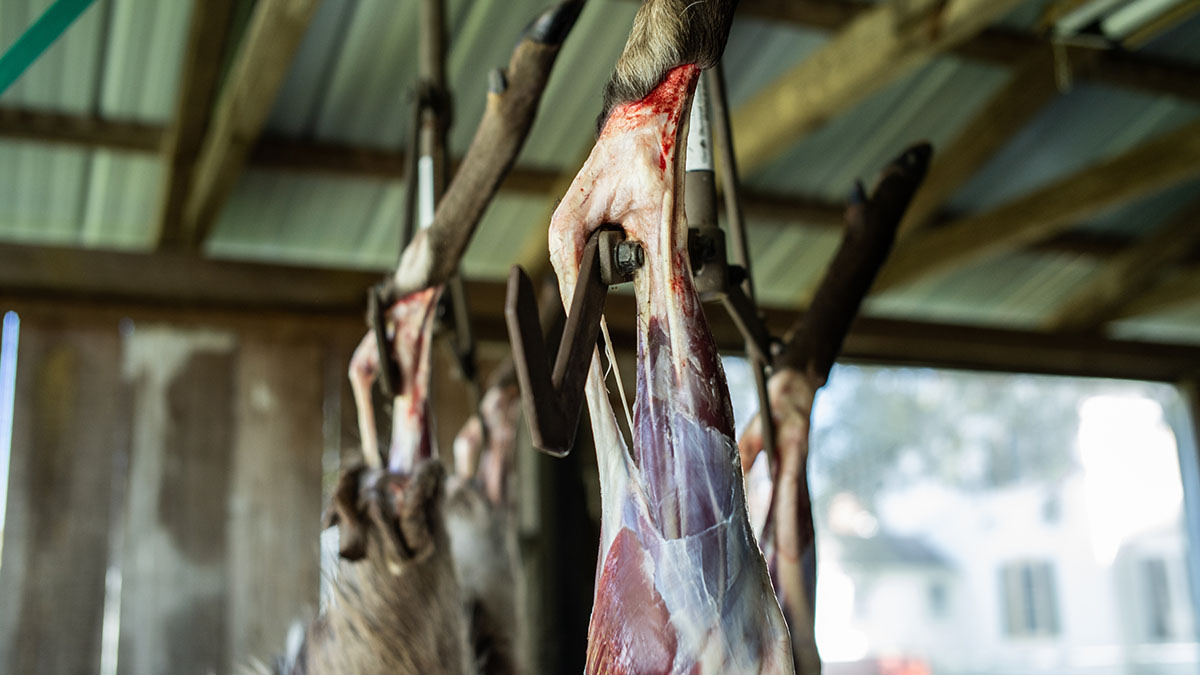
Hunters have been hanging meat from all manner of game animals for a very long time. Under the right conditions, hanging meat does a lot to improve the texture and flavor of game. At MeatEater, we hang whole and quartered big game animals on regular basis, and we can vouch for the fact that it really does make a difference on the table. Nevertheless, we still get a lot of questions on why and how to do it.
Before we get into the hows of hanging and aging meat, it is important to understand why doing so is a good idea. There’s a reason why the best steak houses in the country dry age beef for up to a month. When slowly dry-aging, a variety of complicated physical changes and chemical processes take place in the meat that ultimately results in a better product.
What’s not as important is understanding these things on a cellular level, but there’s some serious science at work in the process. Moisture slowly evaporates out of the meat, and as that water is removed flavors become more intense. Enzymes also start to break down proteins and connective tissue, which tenderizes the meat. Finally, a controlled form of decomposition is taking place not unlike what happens with well-aged cheese, adding even more flavor that can’t be found in fresh meat. All this adds up to tender meat that tastes better than it did before the aging process began.
These things happen over relatively long periods of time in a very tightly controlled environment in the restaurant industry. Combine those factors with the storage space and man hours needed to maintain a non-stop flow of ribeyes, and it begins to make sense why you’ll pay top dollar for a prime cut of beef dry-aged for 28 days. Luckily for hunters, this process is one that can be closely approximated in the field or at home.
If you’re thinking about hanging your deer or elk meat in order to age it, the first and most important consideration should be the average temperature. The ideal meat hanging temperature range that should be maintained should fall somewhere between 33 and 40 degrees. Food safety experts advise against storing meat above 40 degrees, at which point bacterial growth can become a problem.
Next, you should have adequate air flow around the meat while it’s hanging. This helps the meat to remain cool and dry, while also encouraging the formation of what’s called the “rind”. The rind is a dry, protective outer layer of meat which serves as a thick, tough skin that keeps out dirt and bacteria, while also preventing excess moisture loss.
The final goal is to achieve ideal air humidity level, which is recommended to be anywhere from 60 to 85% relative humidity. This level of humidity prevents excessive drying and weight loss in the meat, while remaining low enough to discourage the growth of harmful bacteria. This is the hardest part of dry-aging to achieve for the average hunter, and in our opinion, is the least important for general hanging techniques.
All that being said, we’ve hung meat for over a week out in the field when the temperatures and weather varied greatly day-to-day. We’ve also hung meat in our garages for even longer with ideal temperatures but at much lower humidity levels. You can get away with hanging and aging meat in conditions that aren’t completely perfect, as long as you’re smart about it and keep a close watch on things.
Keep in mind, even if you’re not interested in aging, it’s always a good idea to hang your whole animal, quarters, or boned out meat for at least a day or two in cool temperatures before butchering. This allows the meat to settle and relax out of rigor mortis, which also results in a better end product on the table. A steak from an old, rutty buck that’s hung for a couple days will be a lot more tender than one from a young “meat” buck that’s eaten hours after it died.






